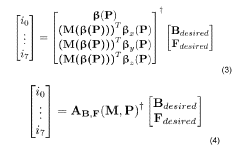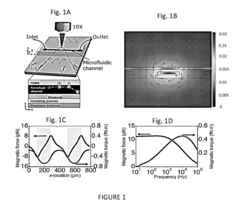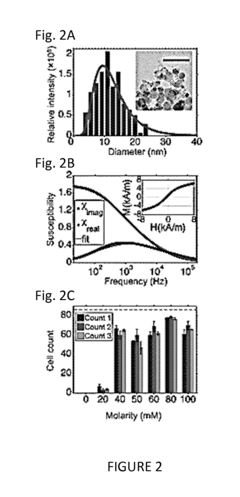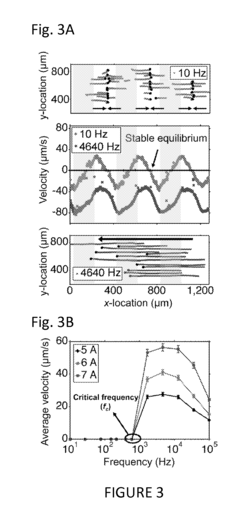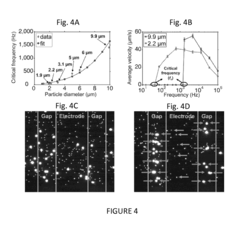How to Advance Medical Technology with Ferrofluid Solutions?
JUL 9, 20259 MIN READ
Generate Your Research Report Instantly with AI Agent
Patsnap Eureka helps you evaluate technical feasibility & market potential.
Ferrofluid in Medicine
Ferrofluids, colloidal suspensions of magnetic nanoparticles, have emerged as a promising technology in the medical field. These unique fluids possess both liquid and magnetic properties, offering a wide range of potential applications in diagnostics, therapeutics, and medical devices. The integration of ferrofluids into medical technology has the potential to revolutionize various aspects of healthcare, from targeted drug delivery to enhanced imaging techniques.
One of the most significant applications of ferrofluids in medicine is in the realm of targeted drug delivery. By encapsulating drugs within ferrofluid nanoparticles, researchers can create a system that can be precisely guided to specific locations within the body using external magnetic fields. This approach offers several advantages over traditional drug delivery methods, including reduced systemic side effects and increased therapeutic efficacy. Furthermore, the ability to concentrate drugs at the site of action could potentially lower the required dosage, leading to more cost-effective treatments.
In the field of medical imaging, ferrofluids have shown promise as contrast agents for magnetic resonance imaging (MRI). The magnetic properties of these fluids can enhance the contrast between different tissues, allowing for more detailed and accurate imaging of various anatomical structures. This improved visualization can aid in the early detection and diagnosis of diseases, particularly in complex organs such as the brain and liver. Additionally, ferrofluid-based contrast agents may offer longer circulation times and reduced toxicity compared to traditional gadolinium-based agents.
Ferrofluids also hold potential in the development of novel medical devices and implants. For instance, researchers are exploring the use of ferrofluids in artificial muscles and actuators for prosthetic limbs, potentially leading to more responsive and lifelike movements. In the field of ophthalmology, ferrofluid-based intraocular lenses are being investigated for their ability to change shape in response to magnetic fields, offering a potential solution for age-related vision problems.
The application of ferrofluids in hyperthermia treatment for cancer is another area of active research. By introducing ferrofluid nanoparticles into tumor tissues and applying an alternating magnetic field, localized heating can be generated, selectively destroying cancer cells while minimizing damage to surrounding healthy tissue. This approach could provide a less invasive alternative to traditional cancer treatments, with potentially fewer side effects.
As research in this field continues to advance, the integration of ferrofluids with other emerging technologies, such as nanotechnology and artificial intelligence, may lead to even more innovative medical applications. For example, the development of smart ferrofluid-based systems that can autonomously navigate through the body and respond to physiological changes could revolutionize personalized medicine and disease monitoring.
One of the most significant applications of ferrofluids in medicine is in the realm of targeted drug delivery. By encapsulating drugs within ferrofluid nanoparticles, researchers can create a system that can be precisely guided to specific locations within the body using external magnetic fields. This approach offers several advantages over traditional drug delivery methods, including reduced systemic side effects and increased therapeutic efficacy. Furthermore, the ability to concentrate drugs at the site of action could potentially lower the required dosage, leading to more cost-effective treatments.
In the field of medical imaging, ferrofluids have shown promise as contrast agents for magnetic resonance imaging (MRI). The magnetic properties of these fluids can enhance the contrast between different tissues, allowing for more detailed and accurate imaging of various anatomical structures. This improved visualization can aid in the early detection and diagnosis of diseases, particularly in complex organs such as the brain and liver. Additionally, ferrofluid-based contrast agents may offer longer circulation times and reduced toxicity compared to traditional gadolinium-based agents.
Ferrofluids also hold potential in the development of novel medical devices and implants. For instance, researchers are exploring the use of ferrofluids in artificial muscles and actuators for prosthetic limbs, potentially leading to more responsive and lifelike movements. In the field of ophthalmology, ferrofluid-based intraocular lenses are being investigated for their ability to change shape in response to magnetic fields, offering a potential solution for age-related vision problems.
The application of ferrofluids in hyperthermia treatment for cancer is another area of active research. By introducing ferrofluid nanoparticles into tumor tissues and applying an alternating magnetic field, localized heating can be generated, selectively destroying cancer cells while minimizing damage to surrounding healthy tissue. This approach could provide a less invasive alternative to traditional cancer treatments, with potentially fewer side effects.
As research in this field continues to advance, the integration of ferrofluids with other emerging technologies, such as nanotechnology and artificial intelligence, may lead to even more innovative medical applications. For example, the development of smart ferrofluid-based systems that can autonomously navigate through the body and respond to physiological changes could revolutionize personalized medicine and disease monitoring.
Medical Market Demand
The medical market for ferrofluid solutions is experiencing significant growth, driven by the increasing demand for innovative and minimally invasive medical treatments. Ferrofluids, which are colloidal liquids containing magnetic nanoparticles, offer unique properties that can be leveraged in various medical applications, creating a substantial market opportunity.
One of the primary areas of demand is in targeted drug delivery systems. The ability to control ferrofluids using external magnetic fields allows for precise localization of therapeutic agents, potentially reducing side effects and improving treatment efficacy. This application is particularly promising in cancer treatment, where targeted delivery of chemotherapy drugs could revolutionize patient care and outcomes.
Another growing market segment is in medical imaging and diagnostics. Ferrofluids can serve as contrast agents in magnetic resonance imaging (MRI), enhancing image quality and enabling more accurate diagnoses. The demand for improved imaging techniques is rising due to the increasing prevalence of chronic diseases and the need for early detection.
In the field of regenerative medicine and tissue engineering, ferrofluids show potential for cell separation and manipulation. This application is gaining traction as personalized medicine and stem cell therapies become more prevalent, driving demand for advanced cell processing technologies.
The market for ferrofluid-based medical devices is also expanding. These include magnetic sealing for implantable devices, magnetic separation systems for blood purification, and magnetically controlled surgical tools. As minimally invasive procedures become more common, the demand for such innovative devices is expected to grow.
Geographically, North America and Europe currently lead the market due to their advanced healthcare infrastructure and higher adoption rates of new technologies. However, emerging economies in Asia-Pacific and Latin America are showing rapid growth potential as healthcare spending increases and access to advanced medical technologies improves.
The aging global population and the rising incidence of chronic diseases are key factors driving the overall demand for advanced medical technologies, including ferrofluid solutions. Additionally, the push for more efficient and cost-effective healthcare delivery is creating opportunities for technologies that can improve treatment outcomes and reduce healthcare costs.
While the market shows promising growth, challenges such as regulatory hurdles and the need for extensive clinical validation may impact adoption rates. However, ongoing research and development efforts, coupled with increasing investment in healthcare innovation, are expected to address these challenges and further expand the market potential for ferrofluid solutions in medical technology.
One of the primary areas of demand is in targeted drug delivery systems. The ability to control ferrofluids using external magnetic fields allows for precise localization of therapeutic agents, potentially reducing side effects and improving treatment efficacy. This application is particularly promising in cancer treatment, where targeted delivery of chemotherapy drugs could revolutionize patient care and outcomes.
Another growing market segment is in medical imaging and diagnostics. Ferrofluids can serve as contrast agents in magnetic resonance imaging (MRI), enhancing image quality and enabling more accurate diagnoses. The demand for improved imaging techniques is rising due to the increasing prevalence of chronic diseases and the need for early detection.
In the field of regenerative medicine and tissue engineering, ferrofluids show potential for cell separation and manipulation. This application is gaining traction as personalized medicine and stem cell therapies become more prevalent, driving demand for advanced cell processing technologies.
The market for ferrofluid-based medical devices is also expanding. These include magnetic sealing for implantable devices, magnetic separation systems for blood purification, and magnetically controlled surgical tools. As minimally invasive procedures become more common, the demand for such innovative devices is expected to grow.
Geographically, North America and Europe currently lead the market due to their advanced healthcare infrastructure and higher adoption rates of new technologies. However, emerging economies in Asia-Pacific and Latin America are showing rapid growth potential as healthcare spending increases and access to advanced medical technologies improves.
The aging global population and the rising incidence of chronic diseases are key factors driving the overall demand for advanced medical technologies, including ferrofluid solutions. Additionally, the push for more efficient and cost-effective healthcare delivery is creating opportunities for technologies that can improve treatment outcomes and reduce healthcare costs.
While the market shows promising growth, challenges such as regulatory hurdles and the need for extensive clinical validation may impact adoption rates. However, ongoing research and development efforts, coupled with increasing investment in healthcare innovation, are expected to address these challenges and further expand the market potential for ferrofluid solutions in medical technology.
Ferrofluid Challenges
Despite the promising potential of ferrofluids in medical technology, several significant challenges hinder their widespread adoption and advancement. One of the primary obstacles is the long-term stability of ferrofluids in biological environments. The complex and dynamic nature of the human body can lead to the degradation of ferrofluid properties over time, potentially compromising their effectiveness in medical applications.
Another critical challenge is biocompatibility and toxicity concerns. While efforts have been made to develop biocompatible ferrofluids, ensuring their complete safety for long-term use in the human body remains a significant hurdle. The potential accumulation of nanoparticles in organs and tissues raises concerns about their long-term effects on human health.
The precise control and manipulation of ferrofluids within the body present another set of challenges. Achieving accurate targeting and localization of ferrofluids to specific areas of interest, such as tumor sites or blood clots, requires sophisticated guidance and control mechanisms. The development of reliable and non-invasive methods for directing and monitoring ferrofluid behavior in vivo is crucial for their successful implementation in medical procedures.
Scale-up and manufacturing challenges also impede the advancement of ferrofluid-based medical technologies. Producing high-quality, consistent ferrofluids at scale while maintaining their unique properties is a complex process. Ensuring batch-to-batch consistency and developing cost-effective production methods are essential for the commercial viability of ferrofluid-based medical solutions.
Regulatory hurdles pose another significant challenge. The novel nature of ferrofluid-based medical technologies means that regulatory frameworks may not be fully equipped to assess their safety and efficacy. Navigating the complex landscape of medical device and drug regulations, particularly for hybrid technologies that combine multiple functionalities, can be time-consuming and resource-intensive.
Lastly, the integration of ferrofluids with existing medical technologies and procedures presents technical and practical challenges. Developing compatible delivery systems, imaging modalities, and treatment protocols that can effectively utilize ferrofluids while seamlessly integrating with current medical practices requires extensive research and development efforts.
Overcoming these challenges will require interdisciplinary collaboration among material scientists, biomedical engineers, clinicians, and regulatory experts. Continued research into novel ferrofluid formulations, advanced control mechanisms, and comprehensive safety studies will be crucial in realizing the full potential of ferrofluids in advancing medical technology.
Another critical challenge is biocompatibility and toxicity concerns. While efforts have been made to develop biocompatible ferrofluids, ensuring their complete safety for long-term use in the human body remains a significant hurdle. The potential accumulation of nanoparticles in organs and tissues raises concerns about their long-term effects on human health.
The precise control and manipulation of ferrofluids within the body present another set of challenges. Achieving accurate targeting and localization of ferrofluids to specific areas of interest, such as tumor sites or blood clots, requires sophisticated guidance and control mechanisms. The development of reliable and non-invasive methods for directing and monitoring ferrofluid behavior in vivo is crucial for their successful implementation in medical procedures.
Scale-up and manufacturing challenges also impede the advancement of ferrofluid-based medical technologies. Producing high-quality, consistent ferrofluids at scale while maintaining their unique properties is a complex process. Ensuring batch-to-batch consistency and developing cost-effective production methods are essential for the commercial viability of ferrofluid-based medical solutions.
Regulatory hurdles pose another significant challenge. The novel nature of ferrofluid-based medical technologies means that regulatory frameworks may not be fully equipped to assess their safety and efficacy. Navigating the complex landscape of medical device and drug regulations, particularly for hybrid technologies that combine multiple functionalities, can be time-consuming and resource-intensive.
Lastly, the integration of ferrofluids with existing medical technologies and procedures presents technical and practical challenges. Developing compatible delivery systems, imaging modalities, and treatment protocols that can effectively utilize ferrofluids while seamlessly integrating with current medical practices requires extensive research and development efforts.
Overcoming these challenges will require interdisciplinary collaboration among material scientists, biomedical engineers, clinicians, and regulatory experts. Continued research into novel ferrofluid formulations, advanced control mechanisms, and comprehensive safety studies will be crucial in realizing the full potential of ferrofluids in advancing medical technology.
Current Applications
01 Composition and preparation of ferrofluid solutions
Ferrofluid solutions are composed of magnetic nanoparticles suspended in a carrier fluid. The preparation involves synthesizing stable colloidal suspensions of magnetic particles, typically iron oxides, in various carrier liquids such as water, oil, or organic solvents. Surfactants are often used to prevent particle agglomeration and maintain stability.- Composition and preparation of ferrofluid solutions: Ferrofluid solutions are composed of magnetic nanoparticles suspended in a carrier fluid. The preparation involves synthesizing stable colloidal suspensions of magnetic particles, typically iron oxides, in various carrier liquids such as water, oil, or organic solvents. Surfactants are often used to prevent particle agglomeration and maintain stability.
- Applications in sealing and lubrication: Ferrofluid solutions are widely used in sealing and lubrication applications. They can form liquid seals around rotating shafts, preventing the passage of gases or liquids while allowing smooth rotation. In lubrication, ferrofluids can be used to reduce friction and wear in various mechanical systems, particularly in environments where traditional lubricants may fail.
- Thermal management and heat transfer: Ferrofluids exhibit unique heat transfer properties due to their magnetic nature. They can be used in cooling systems for electronic devices, where the fluid can be directed to hot spots using magnetic fields. This allows for more efficient heat dissipation and thermal management in compact electronic systems.
- Magnetic field sensing and measurement: Ferrofluid solutions can be utilized in various sensing and measurement applications. Their response to magnetic fields allows for the detection and measurement of field strength and direction. This property is exploited in devices such as accelerometers, inclinometers, and other sensors that rely on the movement or deformation of ferrofluids in response to external forces or fields.
- Optical and display applications: Ferrofluids have unique optical properties that can be manipulated by magnetic fields. This characteristic is used in various display and optical applications, including tunable optical filters, adaptive optics, and novel display technologies. The ability to control the fluid's shape and properties using external magnetic fields allows for dynamic and responsive optical systems.
02 Applications in sealing and lubrication
Ferrofluid solutions are widely used in sealing and lubrication applications. They can form liquid seals in rotating shaft systems, providing effective containment of gases or liquids. In lubrication, ferrofluids can reduce friction and wear in various mechanical systems, enhancing performance and longevity of components.Expand Specific Solutions03 Thermal management and heat transfer
Ferrofluids exhibit unique heat transfer properties due to their magnetic nature. They can be used in cooling systems for electronic devices, transformers, and other heat-generating equipment. The magnetic properties allow for controlled movement and positioning of the fluid, enhancing heat dissipation efficiency.Expand Specific Solutions04 Magnetic field sensing and measurement
Ferrofluid solutions are employed in various sensing and measurement applications involving magnetic fields. They can be used to visualize magnetic field lines, measure field strength, and detect small changes in magnetic fields. This property is utilized in scientific instruments, security systems, and industrial sensors.Expand Specific Solutions05 Novel applications and emerging technologies
Ferrofluids are finding new applications in emerging technologies. These include use in microfluidic devices, adaptive optics, energy harvesting systems, and biomedical applications such as targeted drug delivery and magnetic hyperthermia for cancer treatment. The unique properties of ferrofluids continue to inspire innovative solutions across various fields.Expand Specific Solutions
Key Industry Players
The advancement of medical technology through ferrofluid solutions is currently in an early development stage, with significant potential for growth. The market size is relatively small but expanding rapidly as researchers explore novel applications. The technology's maturity is still evolving, with key players like Yale University, Northwestern University, and Delft University of Technology leading academic research. Companies such as ABIOMED, Inc. and Boston Scientific Scimed, Inc. are actively pursuing commercial applications. The competitive landscape is diverse, involving collaborations between academic institutions, research organizations, and medical device manufacturers. As the technology progresses, we can expect increased competition and market consolidation, with a focus on developing practical medical applications and overcoming regulatory hurdles.
Yale University
Technical Solution: Yale University has developed innovative ferrofluid-based solutions for medical applications. Their research focuses on using ferrofluids for targeted drug delivery and magnetic hyperthermia cancer treatment. The university has created nanoparticle-based ferrofluids that can be precisely controlled using external magnetic fields, allowing for localized drug release in specific areas of the body[1]. Additionally, they have explored the use of ferrofluids in magnetic resonance imaging (MRI) contrast enhancement, improving the visibility of tumors and other abnormalities[2]. Yale's approach combines biocompatible materials with advanced magnetic nanoparticle engineering to create multifunctional ferrofluid platforms for diagnostics and therapeutics[3].
Strengths: Cutting-edge research in targeted drug delivery and cancer treatment. Multifunctional approach combining diagnostics and therapeutics. Weaknesses: Potential challenges in scaling up production for clinical use. Long-term safety and efficacy studies may be required.
ABIOMED, Inc.
Technical Solution: ABIOMED has pioneered the use of ferrofluids in advanced cardiac support devices. Their technology incorporates ferrofluid-based seals and bearings in ventricular assist devices (VADs) and artificial hearts. The company's Impella platform utilizes ferrofluid technology to create a near-frictionless environment for the pump's rotor, significantly reducing wear and extending device longevity[4]. This innovation has enabled the development of smaller, more efficient cardiac support systems that can be implanted with minimally invasive procedures. ABIOMED's ferrofluid solutions also contribute to improved heat dissipation and enhanced overall performance of their cardiac devices[5]. The company continues to refine their ferrofluid technology to develop next-generation heart pumps with increased durability and reduced risk of complications[6].
Strengths: Leader in applying ferrofluids to cardiac support devices. Enables miniaturization and improved efficiency of heart pumps. Weaknesses: Limited to specific cardiac applications. May face regulatory challenges for novel materials in implantable devices.
Core Innovations
Systems and methods for controlling shape and position of a ferrofluid droplet
PatentWO2021041471A1
Innovation
- A system comprising a ferrofluid droplet and an electromagnetic field generation system with a controller that determines and applies necessary magnetic field parameters to control the position and shape of the ferrofluid droplet, using PID controllers for precise manipulation, allowing for shape and position control, and simultaneous position and shape control through the generation and manipulation of controlled magnetic fields.
Label-Free Cellular Manipulation and Sorting Via Biocompatible Ferrofluids
PatentActiveUS20180128729A1
Innovation
- A microfluidic platform using biocompatible ferrofluids with a microfluidic channel and electrodes that generate a magnetic field pattern, allowing for the controlled manipulation and separation of microparticles and live cells based on size, shape, and elasticity, with high efficiency and rapid separation capabilities.
Regulatory Framework
The regulatory framework surrounding ferrofluid solutions in medical technology is complex and multifaceted, requiring careful navigation to ensure compliance and patient safety. In the United States, the Food and Drug Administration (FDA) plays a crucial role in overseeing the development and approval of medical devices and technologies incorporating ferrofluids. These solutions are typically classified as Class II or Class III medical devices, depending on their intended use and potential risks.
The FDA's regulatory pathway for ferrofluid-based medical technologies often involves the premarket notification (510(k)) process or the more rigorous premarket approval (PMA) process. Manufacturers must demonstrate the safety and efficacy of their devices through extensive clinical trials and laboratory testing. Additionally, they must adhere to Good Manufacturing Practices (GMP) and implement robust quality management systems to ensure consistent product quality and safety.
In the European Union, ferrofluid medical technologies fall under the purview of the Medical Device Regulation (MDR). This regulation imposes stringent requirements on manufacturers, including the need for clinical evidence, post-market surveillance, and the appointment of a qualified person responsible for regulatory compliance. The CE marking process is essential for market access in the EU, requiring manufacturers to conduct conformity assessments and prepare technical documentation.
Globally, regulatory bodies such as Health Canada, Japan's Pharmaceuticals and Medical Devices Agency (PMDA), and Australia's Therapeutic Goods Administration (TGA) have their own specific requirements for the approval and marketing of ferrofluid-based medical technologies. Harmonization efforts, such as the International Medical Device Regulators Forum (IMDRF), aim to streamline regulatory processes across different jurisdictions, potentially facilitating faster global market access for innovative ferrofluid solutions.
As ferrofluid technologies advance, regulatory frameworks are likely to evolve to address emerging safety concerns and ethical considerations. Issues such as long-term biocompatibility, potential environmental impacts, and the need for specialized disposal protocols may lead to the development of new guidelines and standards. Manufacturers and researchers must stay abreast of these regulatory changes and engage proactively with regulatory bodies to ensure compliance throughout the product lifecycle.
Furthermore, data protection and privacy regulations, such as the General Data Protection Regulation (GDPR) in the EU and the Health Insurance Portability and Accountability Act (HIPAA) in the US, play a significant role in the development and deployment of ferrofluid-based medical technologies, particularly those involving patient data collection and analysis. Ensuring compliance with these regulations is crucial for the successful implementation and adoption of ferrofluid solutions in healthcare settings.
The FDA's regulatory pathway for ferrofluid-based medical technologies often involves the premarket notification (510(k)) process or the more rigorous premarket approval (PMA) process. Manufacturers must demonstrate the safety and efficacy of their devices through extensive clinical trials and laboratory testing. Additionally, they must adhere to Good Manufacturing Practices (GMP) and implement robust quality management systems to ensure consistent product quality and safety.
In the European Union, ferrofluid medical technologies fall under the purview of the Medical Device Regulation (MDR). This regulation imposes stringent requirements on manufacturers, including the need for clinical evidence, post-market surveillance, and the appointment of a qualified person responsible for regulatory compliance. The CE marking process is essential for market access in the EU, requiring manufacturers to conduct conformity assessments and prepare technical documentation.
Globally, regulatory bodies such as Health Canada, Japan's Pharmaceuticals and Medical Devices Agency (PMDA), and Australia's Therapeutic Goods Administration (TGA) have their own specific requirements for the approval and marketing of ferrofluid-based medical technologies. Harmonization efforts, such as the International Medical Device Regulators Forum (IMDRF), aim to streamline regulatory processes across different jurisdictions, potentially facilitating faster global market access for innovative ferrofluid solutions.
As ferrofluid technologies advance, regulatory frameworks are likely to evolve to address emerging safety concerns and ethical considerations. Issues such as long-term biocompatibility, potential environmental impacts, and the need for specialized disposal protocols may lead to the development of new guidelines and standards. Manufacturers and researchers must stay abreast of these regulatory changes and engage proactively with regulatory bodies to ensure compliance throughout the product lifecycle.
Furthermore, data protection and privacy regulations, such as the General Data Protection Regulation (GDPR) in the EU and the Health Insurance Portability and Accountability Act (HIPAA) in the US, play a significant role in the development and deployment of ferrofluid-based medical technologies, particularly those involving patient data collection and analysis. Ensuring compliance with these regulations is crucial for the successful implementation and adoption of ferrofluid solutions in healthcare settings.
Biocompatibility
Biocompatibility is a critical factor in advancing medical technology with ferrofluid solutions. The integration of ferrofluids into medical applications requires a thorough understanding of their interactions with biological systems to ensure safety and efficacy. Ferrofluids, composed of magnetic nanoparticles suspended in a carrier fluid, present unique challenges in terms of biocompatibility due to their complex composition and magnetic properties.
One of the primary concerns in ferrofluid biocompatibility is the potential for nanoparticle toxicity. The size, shape, and surface chemistry of the magnetic nanoparticles play crucial roles in determining their interactions with cells and tissues. Extensive research has been conducted to optimize these parameters, with a focus on developing nanoparticles that are small enough to avoid rapid clearance by the immune system but large enough to maintain their magnetic properties.
Surface modification of ferrofluid nanoparticles has emerged as a key strategy to enhance biocompatibility. Coating the particles with biocompatible materials such as polyethylene glycol (PEG), dextran, or silica can reduce their immunogenicity and improve their stability in biological environments. These coatings also provide opportunities for functionalization, allowing the attachment of targeting ligands or therapeutic agents to create multifunctional ferrofluid-based systems.
The carrier fluid used in ferrofluid formulations also significantly impacts biocompatibility. Water-based ferrofluids are generally preferred for medical applications due to their inherent compatibility with biological systems. However, the development of biocompatible oil-based ferrofluids has also been explored for specific applications, such as magnetic resonance imaging (MRI) contrast agents.
Long-term biocompatibility and biodegradation of ferrofluids are essential considerations for their use in medical technology. Studies have focused on evaluating the fate of ferrofluid components in the body, including their distribution, metabolism, and excretion. The potential for accumulation of magnetic nanoparticles in organs such as the liver and spleen has been a subject of ongoing research, with efforts directed towards developing ferrofluids that can be safely eliminated from the body over time.
The biocompatibility of ferrofluids extends beyond their direct interactions with biological tissues to include their effects on cellular functions and physiological processes. Research has shown that carefully designed ferrofluids can exhibit minimal cytotoxicity and maintain cell viability, even promoting certain cellular functions in some cases. However, the potential for ferrofluids to induce oxidative stress or disrupt cell membranes remains an area of active investigation.
Advancing medical technology with ferrofluid solutions requires a multidisciplinary approach to biocompatibility, combining expertise from materials science, nanotechnology, and biomedical engineering. As research progresses, the development of standardized protocols for assessing ferrofluid biocompatibility will be crucial for translating these innovative materials into clinical applications, ultimately leading to safer and more effective medical technologies.
One of the primary concerns in ferrofluid biocompatibility is the potential for nanoparticle toxicity. The size, shape, and surface chemistry of the magnetic nanoparticles play crucial roles in determining their interactions with cells and tissues. Extensive research has been conducted to optimize these parameters, with a focus on developing nanoparticles that are small enough to avoid rapid clearance by the immune system but large enough to maintain their magnetic properties.
Surface modification of ferrofluid nanoparticles has emerged as a key strategy to enhance biocompatibility. Coating the particles with biocompatible materials such as polyethylene glycol (PEG), dextran, or silica can reduce their immunogenicity and improve their stability in biological environments. These coatings also provide opportunities for functionalization, allowing the attachment of targeting ligands or therapeutic agents to create multifunctional ferrofluid-based systems.
The carrier fluid used in ferrofluid formulations also significantly impacts biocompatibility. Water-based ferrofluids are generally preferred for medical applications due to their inherent compatibility with biological systems. However, the development of biocompatible oil-based ferrofluids has also been explored for specific applications, such as magnetic resonance imaging (MRI) contrast agents.
Long-term biocompatibility and biodegradation of ferrofluids are essential considerations for their use in medical technology. Studies have focused on evaluating the fate of ferrofluid components in the body, including their distribution, metabolism, and excretion. The potential for accumulation of magnetic nanoparticles in organs such as the liver and spleen has been a subject of ongoing research, with efforts directed towards developing ferrofluids that can be safely eliminated from the body over time.
The biocompatibility of ferrofluids extends beyond their direct interactions with biological tissues to include their effects on cellular functions and physiological processes. Research has shown that carefully designed ferrofluids can exhibit minimal cytotoxicity and maintain cell viability, even promoting certain cellular functions in some cases. However, the potential for ferrofluids to induce oxidative stress or disrupt cell membranes remains an area of active investigation.
Advancing medical technology with ferrofluid solutions requires a multidisciplinary approach to biocompatibility, combining expertise from materials science, nanotechnology, and biomedical engineering. As research progresses, the development of standardized protocols for assessing ferrofluid biocompatibility will be crucial for translating these innovative materials into clinical applications, ultimately leading to safer and more effective medical technologies.
Unlock deeper insights with Patsnap Eureka Quick Research — get a full tech report to explore trends and direct your research. Try now!
Generate Your Research Report Instantly with AI Agent
Supercharge your innovation with Patsnap Eureka AI Agent Platform!


